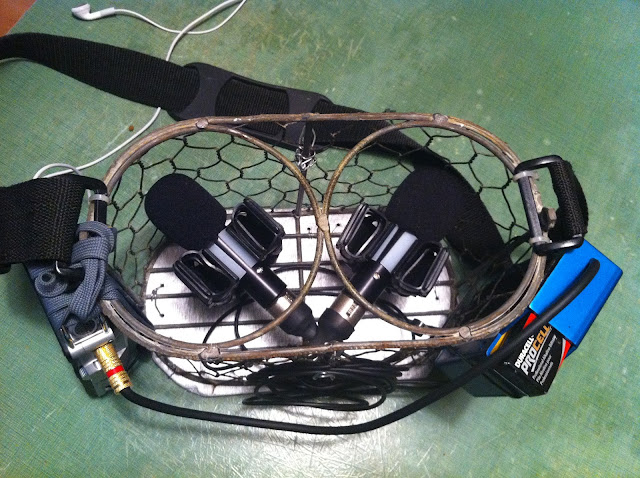A few days ago I posted a few pix of the stealth rig I'm developing to the twitter and got some interested responses, so I'll spell out what I'm thinking in a little more detail here.
I'm actually surprised there's not a commercially available hyper portable rig with suspension and wind protection available out on the market. Here are the needs I'm trying to address:
- inconspicuousness - I'd like to be able to take this out into a crowd and not get strange looks. I'd also like it to not look like a bomb.
- wind protection - very important to be able to take this out into low to moderate wind conditions and get usable recordings
- low handling noise - I'd like the rig to be well suspended enough that I can carry it while walking without audible bumps
- all in one - I want the entire rig to be together - recorder, cables, shockmount and mics in one package.
Why not just roll that D50 out there in those situations? In many cases I do. The D50 meets all of the above criteria and does them beautifully. (yes, I can totally walk around with it and not get handling noise)
But with all of that said when I can I'd like to run better mics. The D50s mics are just fine for most things but I really do like my CM3s quite a bit more, and if I can create the option to use them in stealth situations then I would very much like to, so I've built this:
So here are the basic components:
-The cage: In this case I'm using a wire wine holder I got at Hobby Lobby. I stripped off some of the extraneous decorative wood and other bits, and was left with a sturdy steel cage and a chickenwire surround.
- The mounts: The shockmounts were part of the
CM3 package that I bought from No Hype Audio. They're very nice, compact, and they mount into the wooden bottom that I've attached to the bottom of the cage.
- The cables: I was looking to make the most low-pro cables I could, so I jumped on Markertek and found this
mogami w2697 lav mic cable (cheap), and a pair of
Neutrick NM3FXI female XLRs that are basically half-length. I got some heat shrink to work as protection and strain relief. The upside to this type of cabling is that its super low pro and flexible. The downside is that it's not nearly as rf-shielded as a thicker and less flexible cable. I may try to build a pair of short right angle cables in the future.
- The recorders: That's a Deneke PS-2 on the right providing XLR in and phantom power (just tie wrapped on for now) and the PCM D50 on the left.
-the wind protection - still in testing. I'm in the process of testing out various covers and layouts that would work here. One idea I had was to take a piece of cloth and attach it to the bottom, then kind of flap it over and cover the entire device from front to back. This leaves access along the sides (through the folds of the cloth) to the recording devices. Another idea would be a basic pillow-case type cover that just plops over the top and is measured to the right length. recorder access would be the issue to get addressed when fabricating that way. I'm also testing which fabrics give me the best wind protection/transparency ratio. I was pretty surprised to find out how much high end the rode deadcat was knocking down, so I still have much to learn there.
so that's it. The rig works fine, it's kind of lunchboxy when I use the flannel cover, and it sounds great.
comment with any other questions you may have.





